Submitted:
03 July 2023
Posted:
04 July 2023
You are already at the latest version
Abstract

Keywords:
1. Introduction
1.1. Difference between post-industrial recycling and post-consumer recycling
1.2. Measuring circularity
2. Materials and Methods
2.1. Effective circularity
- Level 1: Closed-loop recycling of a product into the identical production application
- Level 2: Quasi-closed-loop recycling with restricted but defined reuse in products that are managed by the same recycling system
- Level 3: Open-loop recycling, reuse in alternative products that might be further managed by another recycling system (also referred to as recycling cascade)
2.2. Combining effective circularity and environmental impact assessment
2.2.1. Environmentally efficient circularity
2.2.2. Impact reduction potential of using recycled granulate
2.3. Transfer to the case study example of polypropylene used for packaging
2.3.1. Effective circularity
2.3.2. Environmentally efficient circularity and impact reduction potential
3. Results and discussion
3.1. Effective circularity
3.2. Environmentally efficient circularity
3.3. Impact reduction potential
3.4. Applicability and limitations
4. Conclusion and outlook
Supplementary Materials
Author Contributions
Funding
Data Availability Statement
Conflicts of Interest
Appendix A
References
- Corona, B.; Shen, L.; Reike, D.; Rosales Carreón, J.; Worrell, E. Towards sustainable development through the circular economy—A review and critical assessment on current circularity metrics. Resources, Conservation and Recycling 2019, 151, 104498. [Google Scholar] [CrossRef]
- Nikolaou, I.E.; Jones, N.; Stefanakis, A. Circular Economy and Sustainability: The Past. the Present and the Future Directions, Circular Economy and Sustainability 2021, 1, 1–20. [Google Scholar] [CrossRef]
- Schroeder, P.; Anggraeni, K.; Weber, U. The Relevance of Circular Economy Practices to the Sustainable Development Goals. Journal of Industrial Ecology 2018, 23. [Google Scholar] [CrossRef]
- Ellen MacArthur Foundation. Towards a circular economy Business rationale for an accelerated transition. 2015. Available online: https://emf.thirdlight.com/file/24/_A-BkCs_h7gfln_Am1g_JKe2t9/Towards%20a%20circular%20economy%3A%20Business%20rationale%20for%20an%20accelerated%20transition.pdf.
- European Commission. A new Circular Economy Action Plan For a cleaner and more competitive Europe: COM/2020/98 final. 2020.
- Elia, V.; Gnoni, M.G.; Tornese, F. Measuring circular economy strategies through index methods: A critical analysis. Journal of Cleaner Production 2017, 142, 2741–2751. [Google Scholar] [CrossRef]
- Geissdoerfer, M.; Savaget, P.; Bocken, N.M.; Hultink, E.J. The Circular Economy – A new sustainability paradigm? Journal of Cleaner Production 2017, 143, 757–768. [Google Scholar] [CrossRef]
- Ghisellini, P.; Cialani, C.; Ulgiati, S. A review on circular economy: The expected transition to a balanced interplay of environmental and economic systems. Journal of Cleaner Production 2016, 114, 11–32. [Google Scholar] [CrossRef]
- King, S.; Locock, K.E. A circular economy framework for plastics: A semi-systematic review. Journal of Cleaner Production 2022, 364, 132503. [Google Scholar] [CrossRef]
- European Commission. A European Strategy for Plastics in a Circular Economy: COM(2018) 28 final. 2018.
- Yuan, X.; Wang, X.; Sarkar, B.; Ok, Y.S. The covid-19 pandemic necessitates a shift to a plastic circular economy. Nature reviews. Earth & environment 2021, 2, 659–660. [Google Scholar] [CrossRef]
- Johansen, M.R.; Christensen, T.B.; Ramos, T.M.; Syberg, K. A review of the plastic value chain from a circular economy perspective. Journal of environmental management 2022, 302 Pt A, 113975. [Google Scholar] [CrossRef]
- Plastics Europe. Plastics - The Facts 2022. 2022. Available online: https://plasticseurope.org/knowledge-hub/plastics-the-facts-2022/.
- Bibas, R.; Chateau, J.; Lanzi, E.; Mavroeidi, E.; Ostalé Valriberas, D. Global Plastic projections to 2050: Economic drivers and environmental consequences. 2020.
- van der Harst, E.; Potting, J.; Kroeze, C. Comparison of different methods to include recycling in lcas of aluminium cans and disposable polystyrene cups. Waste management (New York, N.Y.) 2016, 48, 565–583. [Google Scholar] [CrossRef]
- Martínez Leal, J.; Pompidou, S.; Charbuillet, C.; Perry, N. Design for and from Recycling: A Circular Ecodesign Approach to Improve the Circular Economy. Sustainability 2020, 12, No 23, 9861. [Google Scholar] [CrossRef]
- Schulte, A.; Velarde, P.Á.S.; Marbach, L.; Mörbitz, P. Measuring the circularity potential of recycled LDPE based on quantity and quality conservation - a functional requirement matrix approach. Resources, Conservation & Recycling Advances 2023, 17, 200127. [Google Scholar] [CrossRef]
- DIN. Environmental labels and declarations - Self-declared environmental claims (Type II environmental labelling): ISO 14021.
- Hubo, S.; Ragaert, K.; Leite, L.; Martins, C. Evaluation of post-industrial and post-consumer polyolefin-based polymer waste streams for injection moulding. In Proceedings of the 6th Polymers & Mould Innovations International Conference, 2014; Institute for Polymers and Composites, 2014; pp. 201–206. [Google Scholar]
- Nessi, S.; Sinkko, T.; Bulgheroni, C.; Garcia-Gutierrez, P.; Giuntoli, J.; Konti, A.; Sanye-Mengual, E.; Tonini, D.; Pant, R.; Marelli, L.; Ardente, F. Life cycle assessment (lca) of alternative feedstocks for plastics production; Publications Office of the European Union: Luxembourg, 2021. [Google Scholar] [CrossRef]
- Rigamonti, L.; Mancini, E. Life cycle assessment and circularity indicators. The International Journal of Life Cycle Assessment 2021. [CrossRef]
- Pereira Domingues Martinho, V.J. Insights into circular economy indicators: Emphasizing dimensions of sustainability. Environmental and Sustainability Indicators 2021, 10, 100119. [Google Scholar] [CrossRef]
- Moraga, G.; Huysveld, S.; Mathieux, F.; Blengini, G.A.; Alaerts, L.; van Acker, K.; Meester S de Dewulf, J. Circular economy indicators: What do they measure? Resources, conservation, and recycling 2019, 146, 452–461. [Google Scholar] [CrossRef] [PubMed]
- Mishra, S.; Singh, S.P.; Johansen, J.; Cheng, Y.; Farooq, S. Evaluating indicators for international manufacturing network under circular economy. Management Decision 2019, 57, 811–839. [Google Scholar] [CrossRef]
- Jerome, A.; Helander, H.; Ljunggren, M.; Janssen, M. Mapping and testing circular economy product-level indicators: A critical review. Resources, Conservation and Recycling 2022, 178, 106080. [Google Scholar] [CrossRef]
- Janik, A.; Ryszko, A. Circular economy in companies: An analysis of selected indicators from a managerial perspective. Multidisciplinary Aspects of Production Engineering 2019, 2, 523–535. [Google Scholar] [CrossRef]
- Jain, S.; Jain, N.K.; Metri, B. Strategic framework towards measuring a circular supply chain management. Benchmarking: An International Journal 2018, 25, 3238–3252. [Google Scholar] [CrossRef]
- Helander, H.; Petit-Boix, A.; Leipold, S.; Bringezu, S. How to monitor environmental pressures of a circular economy: An assessment of indicators. Journal of Industrial Ecology 2019, 139, 1011. [Google Scholar] [CrossRef]
- Harris, S.; Martin, M.; Diener, D. Circularity for circularity's sake? Scoping review of assessment methods for environmental performance in the circular economy. Sustainable Production and Consumption 2021, 26, 172–186. [Google Scholar] [CrossRef]
- Garcia-Saravia Ortiz-de-Montellano, C.; van der Meer, Y. A Theoretical Framework for Circular Processes and Circular Impacts Through a Comprehensive Review of Indicators. Global Journal of Flexible Systems Management 2022, 23, 291–314. [Google Scholar] [CrossRef]
- Chrispim, M.C.; Mattsson, M.; Ulvenblad, P. The underrepresented key elements of Circular Economy: A critical review of assessment tools and a guide for action. Sustainable Production and Consumption 2023, 35, 539–558. [Google Scholar] [CrossRef]
- Calzolari, T.; Genovese, A.; Brint, A. Circular Economy indicators for supply chains: A systematic literature review. Environmental and Sustainability Indicators 2022, 13, 100160. [Google Scholar] [CrossRef]
- Camacho-Otero, J.; Boks, C.; Pettersen, I. Consumption in the Circular Economy: A Literature Review. Sustainability 2018, 10, 2758. [Google Scholar] [CrossRef]
- Parchomenko, A.; Nelen, D.; Gillabel, J.; Rechberger, H. Measuring the circular economy - A Multiple Correspondence Analysis of 63 metrics. Journal of Cleaner Production 2019, 210, 200–216. [Google Scholar] [CrossRef]
- Saidani, M.; Yannou, B.; Leroy, Y.; Cluzel, F.; Kendall, A. A taxonomy of circular economy indicators, submitted to the Journal of Cleaner Production 2019.
- Iacovidou, E.; Velis, C.A.; Purnell, P.; Zwirner, O.; Brown, A.; Hahladakis, J.; Millward-Hopkins, J.; Williams, P.T. Metrics for optimising the multi-dimensional value of resources recovered from waste in a circular economy: A critical review. Journal of Cleaner Production 2017, 166, 910–938. [Google Scholar] [CrossRef]
- WBCSD. Circular Metrics Landscape Analysis. 2018. Available online: http://docs.wbcsd.org/2018/06/Circular_Metrics-Landscape_analysis.pdf.
- Ellen MacArthur Foundation. Circularity-Indicators: An approach to Measuring Circularity. Methodology. 2015. Available online: https://ellenmacarthurfoundation.org/material-circularity-indicator.
- Huysman, S.; de Schaepmeester, J.; Ragaert, K.; Dewulf, J.; de Meester, S. Performance indicators for a circular economy: A case study on post-industrial plastic waste. Resources, Conservation and Recycling 2017, 120, 46–54. [Google Scholar] [CrossRef]
- Glogic, E.; Sonnemann, G.; Young, S.B. Environmental Trade-Offs of Downcycling in Circular Economy: Combining Life Cycle Assessment and Material Circularity Indicator to Inform Circularity Strategies for Alkaline Batteries. Sustainability 2021, 13, 1040. [Google Scholar] [CrossRef]
- Bailey, R.; Janet, K.; Bras, A.; Bras, B. Applying Ecological Input-Output Flow Analysis to Material Flows in Industrial Systems: Part I: Tracing Flows. Journal of Industrial Ecology 2004, 8, 45–68. [Google Scholar] [CrossRef]
- Figge, F.; Thorpe, A.S.; Givry, P.; Canning, L.; Franklin-Johnson, E. Longevity and Circularity as Indicators of Eco-Efficient Resource Use in the Circular Economy. Ecological Economics 2018, 150, 297–306. [Google Scholar] [CrossRef]
- Klose, S.; Pauliuk, S. Quantifying longevity and circularity of copper for different resource efficiency policies at the material and product levels. Journal of Industrial Ecology 2021. [CrossRef]
- Pauliuk, S. Critical appraisal of the circular economy standard BS 8001:2017 and a dashboard of quantitative system indicators for its implementation in organizations. Resources, Conservation and Recycling 2018, 129, 81–92. [Google Scholar] [CrossRef]
- Drucker, P.F. Management; Routledge, 2012. [Google Scholar]
- The World Business Council for Sustainable Development. Eco-efficiency and cleaner production: Charting the course to sustainability. Available online: https://enb.iisd.org/consume/unep.html.
- Huppes, G.; Ishikawa, M. A Framework for Quantified Eco-efficiency Analysis - Huppes - 2005 - Journal of Industrial Ecology - Wiley Online Library. Journal of Industrial Ecology 2005, 9, 25–41. [Google Scholar] [CrossRef]
- Maxime, D.; Marcotte, M.; Arcand, Y. Development of eco-efficiency indicators for the Canadian food and beverage industry. Journal of Cleaner Production 2006, 14, 636–648. [Google Scholar] [CrossRef]
- British Standards Institution. Framework for implementing the principles of the circular economy in organizations – guide; BSI: Frankfurt am Main, 2017. [Google Scholar]
- Albrecht, S.; Brandstetter, P.; Beck, T.; Fullana-i-Palmer, P.; Grönman, K.; Baitz, M.; Deimling, S.; Sandilands, J.; Fischer, M. An extended life cycle analysis of packaging systems for fruit and vegetable transport in Europe. The International Journal of Life Cycle Assessment 2013, 18, 1549–1567. [Google Scholar] [CrossRef]
- Pinter, E.; Welle, F.; Mayrhofer, E.; Pechhacker, A.; Motloch, L.; Lahme, V.; Grant, A.; Tacker, M. Circularity Study on PET Bottle-To-Bottle Recycling. Sustainability 2021, 13, 7370. [Google Scholar] [CrossRef]
- European Commission. 15Th update of the register of valid applications for authorisation of recycling processes to produce recycled plastic materials and articles of intended to come into contact with foods submitted under article 13 of regulations. (EC) NO 282/2008.
- DIN EN ISO 14040; Environmental management – Life cycle assessment – Principles and framework: ISO 14040.
- DIN EN ISO 14044; Environmental management – Life cycle assessment – Requirements and guidelines: ISO 14044. 2006.
- Ekvall, T.; Björklund, A.; Sandin, G. Modeling recycling in life cycle assessment. 2020.
- Tonini, D.; Schrijvers, D.; Nessi, S.; Garcia-Gutierrez, P.; Giuntoli, J. Carbon footprint of plastic from biomass and recycled feedstock: Methodological insights. The International Journal of Life Cycle Assessment 2021, 26, 221–237. [Google Scholar] [CrossRef]
- Ekvall, T.; Björklund, A.; Sandin, G.; Jelse, K.; Lagergren, J.; Rydberg, M. Modeling recycling in life cycle assessment. 2020.
- Brander, M.; Wylie, C. The use of substitution in attributional life cycle assessment. Greenhouse Gas Measurement and Management 2011, 1, 161–166. [Google Scholar] [CrossRef]
- Eriksson, O.; Carlsson Reich, M.; Frostell, B.; Björklund, A.; Assefa, G.; Sundqvist, J.-O.; Granath, J.; Baky, A.; Thyselius, L. Municipal solid waste management from a systems perspective. Journal of Cleaner Production 2005, 13, 241–252. [Google Scholar] [CrossRef]
- Astrup, T.; Fruergaard, T.; Christensen, T.H. Recycling of plastic: Accounting of greenhouse gases and global warming contributions. Waste management & research 2009, 27, 763–772. [Google Scholar] [CrossRef]
- Conversio Market & Strategy GmbH. Stoffstrombild Kunststoffe in Deutschland 2017. 2018.
- Picuno, C.; Alassali, A.; Chong, Z.K.; Kuchta, K. Flows of post-consumer plastic packaging in Germany: An MFA-aided case study. Resources Conservation and Recycling 2021, 169, 105515. [Google Scholar] [CrossRef]
- IPCC. Climate Change 2022: Impacts, Adaptation, and Vulnerability.: Contribution of Working Group II to the Sixth Assessment Report of the Intergovernmental Panel on Climate Change; Cambridge, UK; New York, 2022.
- Rockström, J.; Steffen, W.; Noone, K.; Persson, Å.; Chapin, F.S., III; Lambin, E.; Lenton, T.M.; Scheffer, M.; Folke, C.; Schellnhuber, H.J.; et al. Planetary Boundaries: Exploring the Safe Operating Space for Humanity. Ecology and Society 2009, 14. [Google Scholar] [CrossRef]
- Matthews, J.B.R.; Möller, V.; van Diemen, R.; Fuglestvedt, J.S.; Masson-Delmotte, V.; Méndez, C.; Semenov, S.; Reisinger, A. IPCC 2021: Annex VII: Glossary, Climate Change 2021: The Physical Science Basis. Contribution of Working Group I to the Sixth Assessment Report of the Intergovernmental Panel on Climate Change.
- Rogelj, J.; Elzen M den Höhne, N.; Fransen, T.; Fekete, H.; Winkler, H.; Schaeffer, R.; Sha, F.; Riahi, K.; Meinshausen, M. Paris agreement climate proposals need a boost to keep warming well below 2 °c. Nature 2016, 534, 631–639. [Google Scholar] [CrossRef]
- Chen, P.-Y.; Chen, S.-T.; Hsu, C.-S.; Chen, C.-C. Modeling the global relationships among economic growth. energy consumption and CO2 emissions, Renewable and Sustainable Energy Reviews 2016, 65, 420–431. [Google Scholar] [CrossRef]
- Da Costa, H.M.; Ramos, V.D.; de Oliveira, M.G. Degradation of polypropylene (PP) during multiple extrusions: Thermal analysis. mechanical properties and analysis of variance, Polymer Testing 2007, 26, 676–684. [Google Scholar] [CrossRef]
- European Commission. Amending Decision 2005/270/EC establishing the formats relating to the database system pursuant to European Parliament and Council Directive 94/62/EC on packaging and packaging waste: EU-2019/665. 2019.
- European Parliament and Council. Packaging and packaging waste: Directive 94/62/EC. 1994.
- Umweltbundesamt (2021): Aufkommen und Verwertung von Verpackungsabfällen in Deutschland im Jahr 2019 (2021). Available online: https://www.umweltbundesamt.de/sites/default/files/medien/479/publikationen/texte_148-2021_aufkommen_und_verwertung_von_verpackungsabfaellen_in_deutschland_im_jahr_2019.pdf.
- Antonopoulos, I.; Faraca, G.; Tonini, D. Recycling of post-consumer plastic packaging waste in the eu: Recovery rates, material flows, and barriers. Waste management (New York, N.Y.) 2021, 126, 694–705. [Google Scholar] [CrossRef]
- Tua, C.; Biganzoli, L.; Grosso, M.; Rigamonti, L. Life Cycle Assessment of Reusable Plastic Crates (RPCs). Resources 2019, 8, 110. [Google Scholar] [CrossRef]
- Schwarz, A.E.; Ligthart, T.N.; Godoi Bizarro, D.; de Wild, P.; Vreugdenhil, B.; van Harmelen, T. Plastic recycling in a circular economy; determining environmental performance through an lca matrix model approach. Waste management (New York, N.Y.) 2021, 121, 331–342. [Google Scholar] [CrossRef]
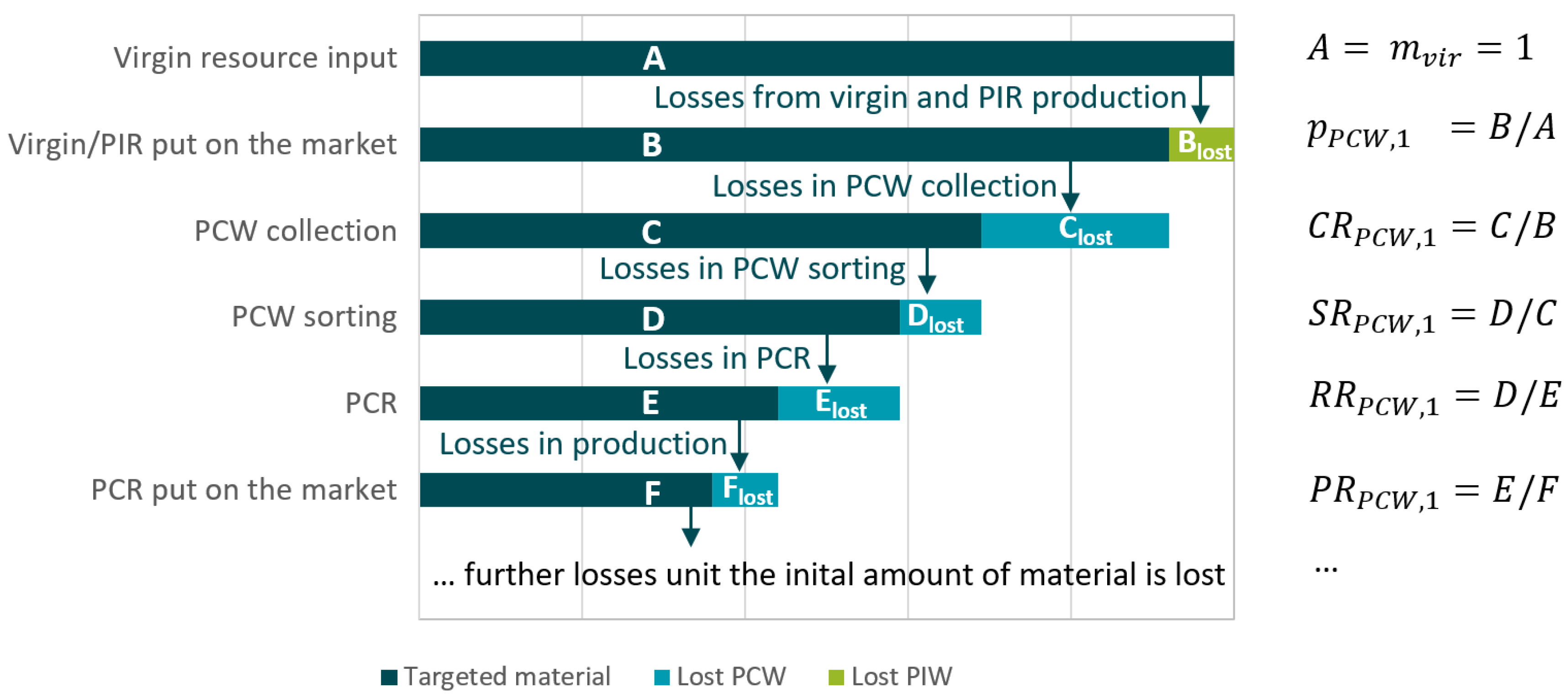
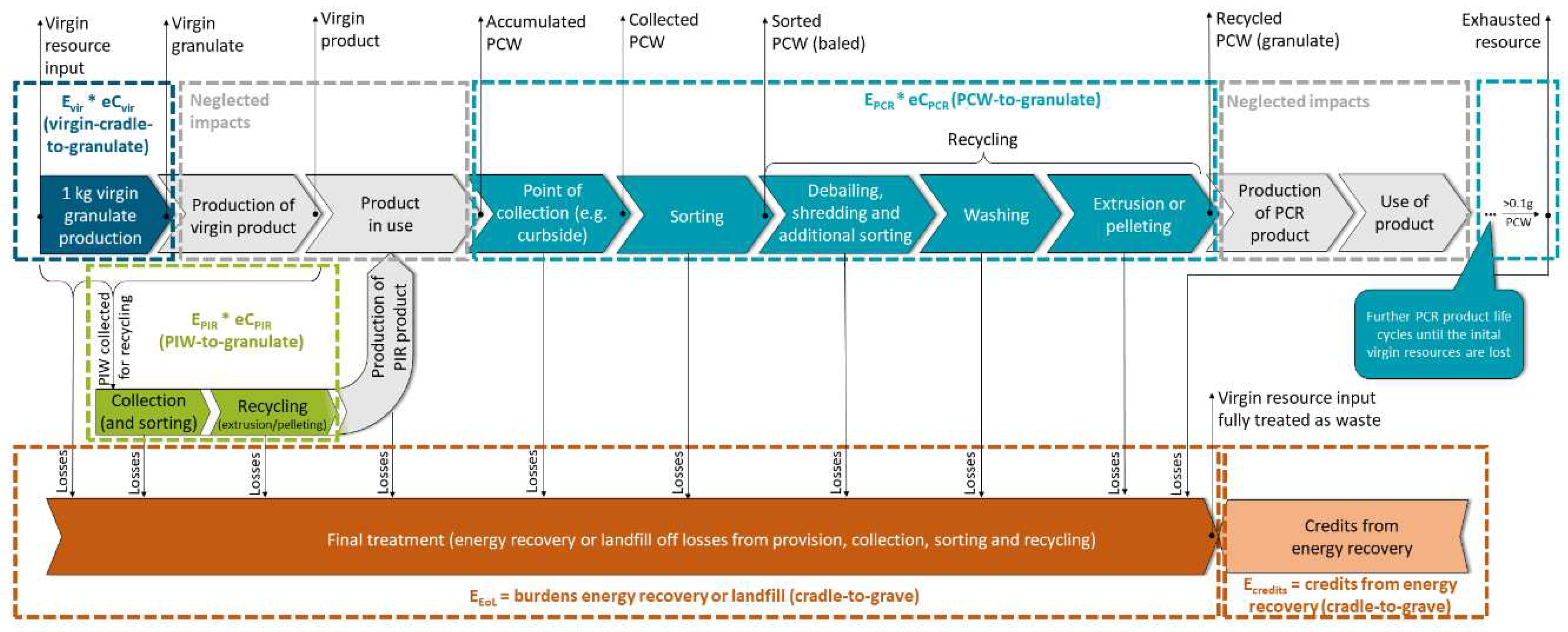
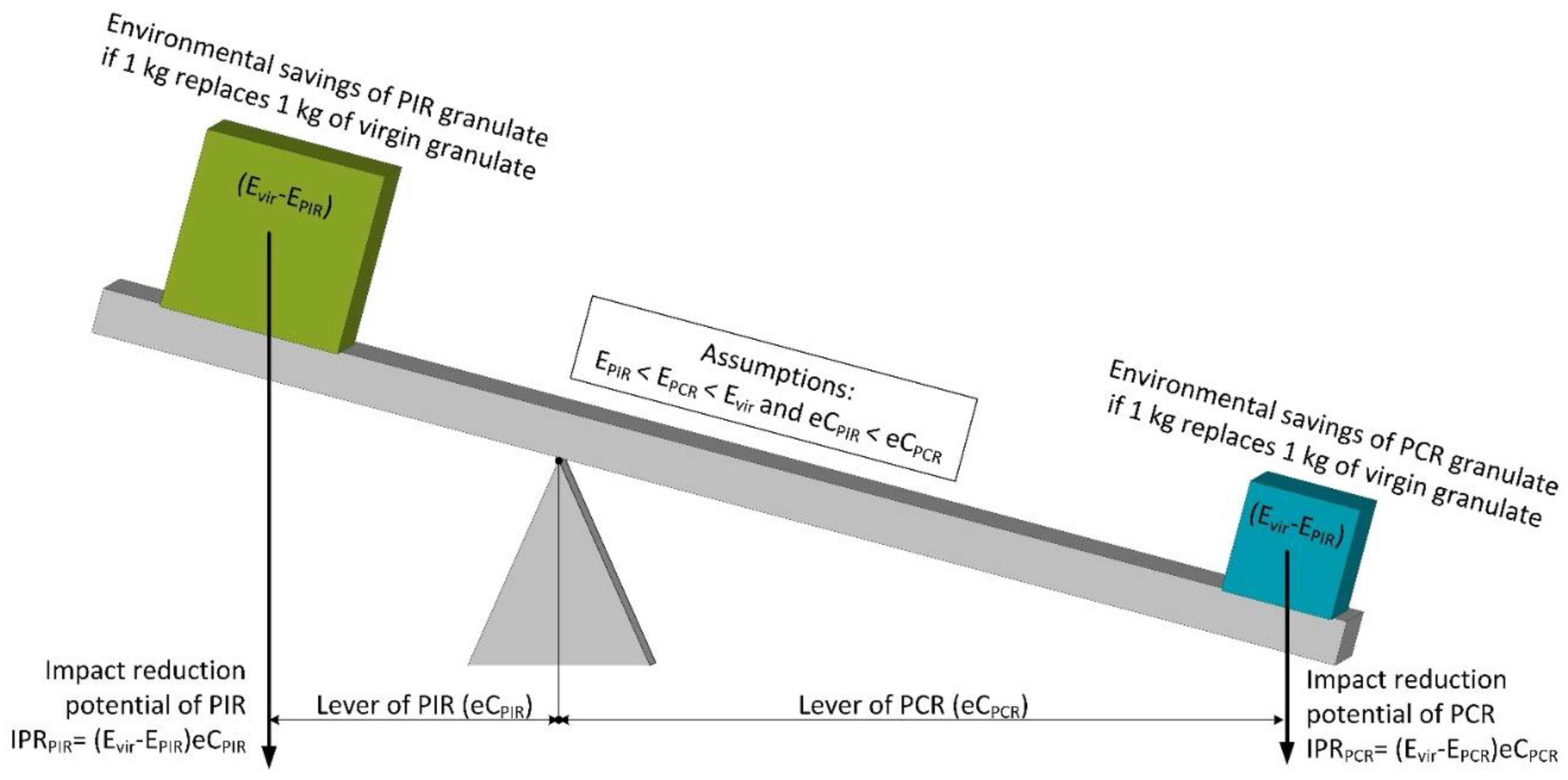
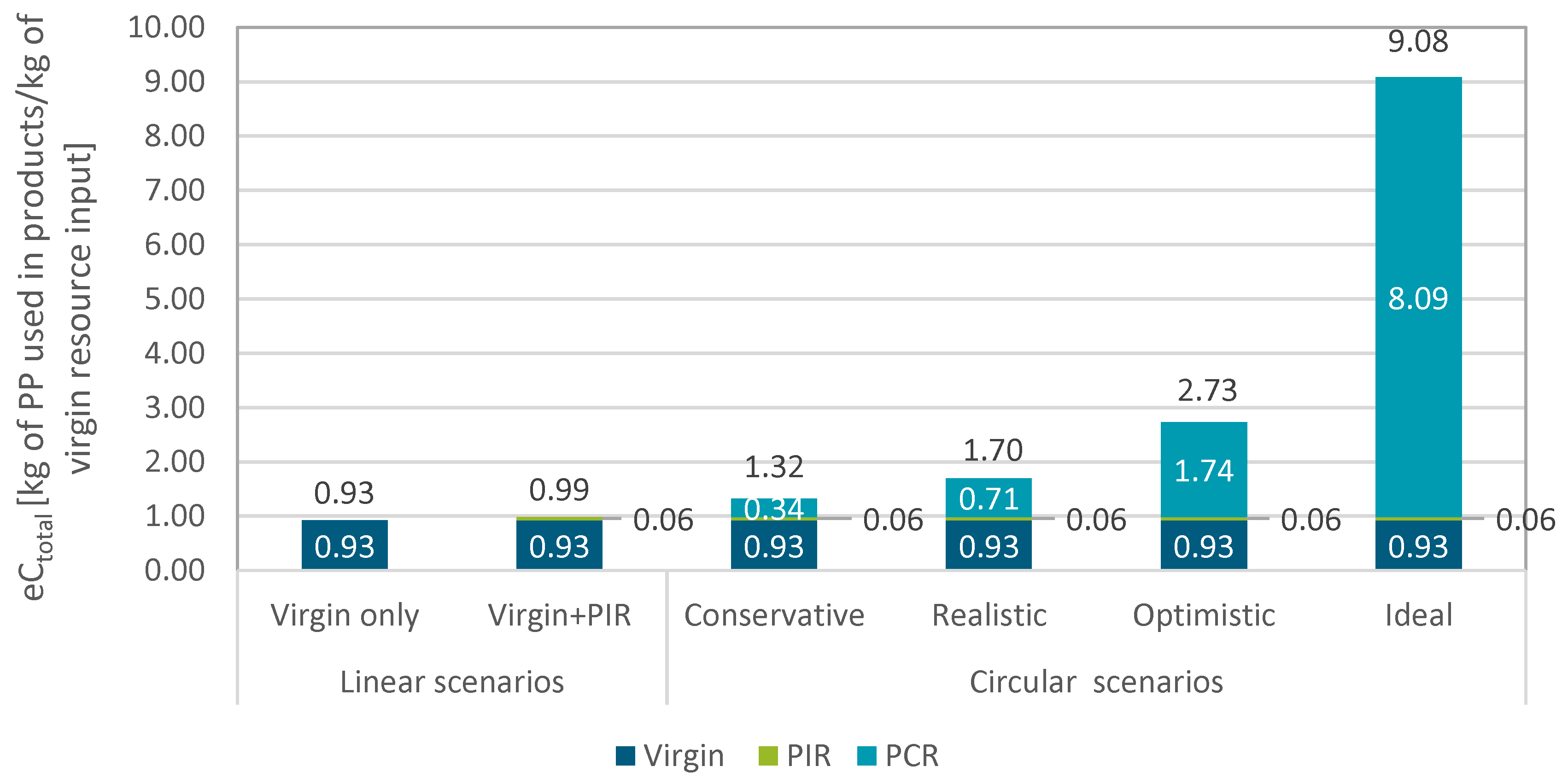
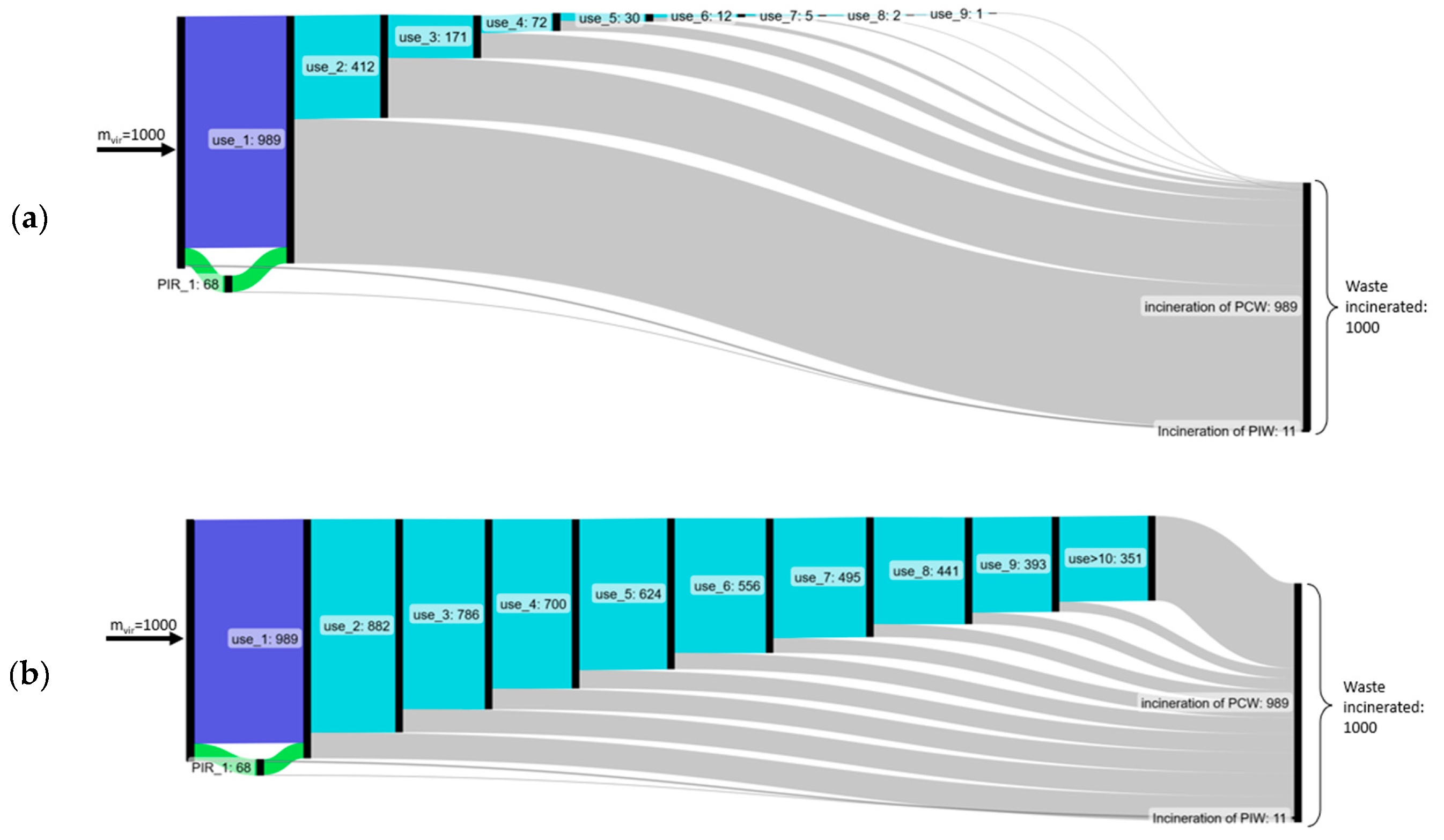
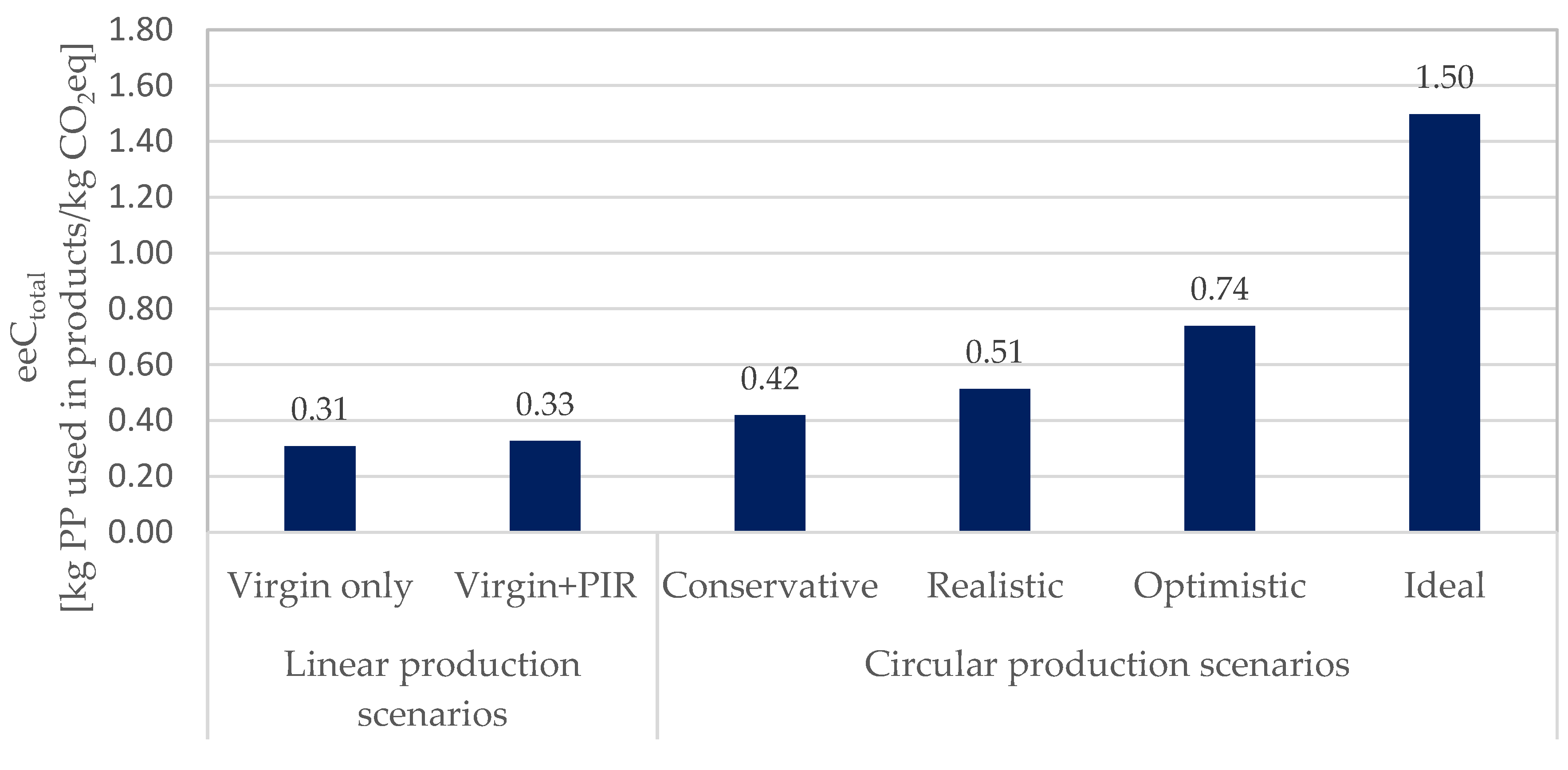
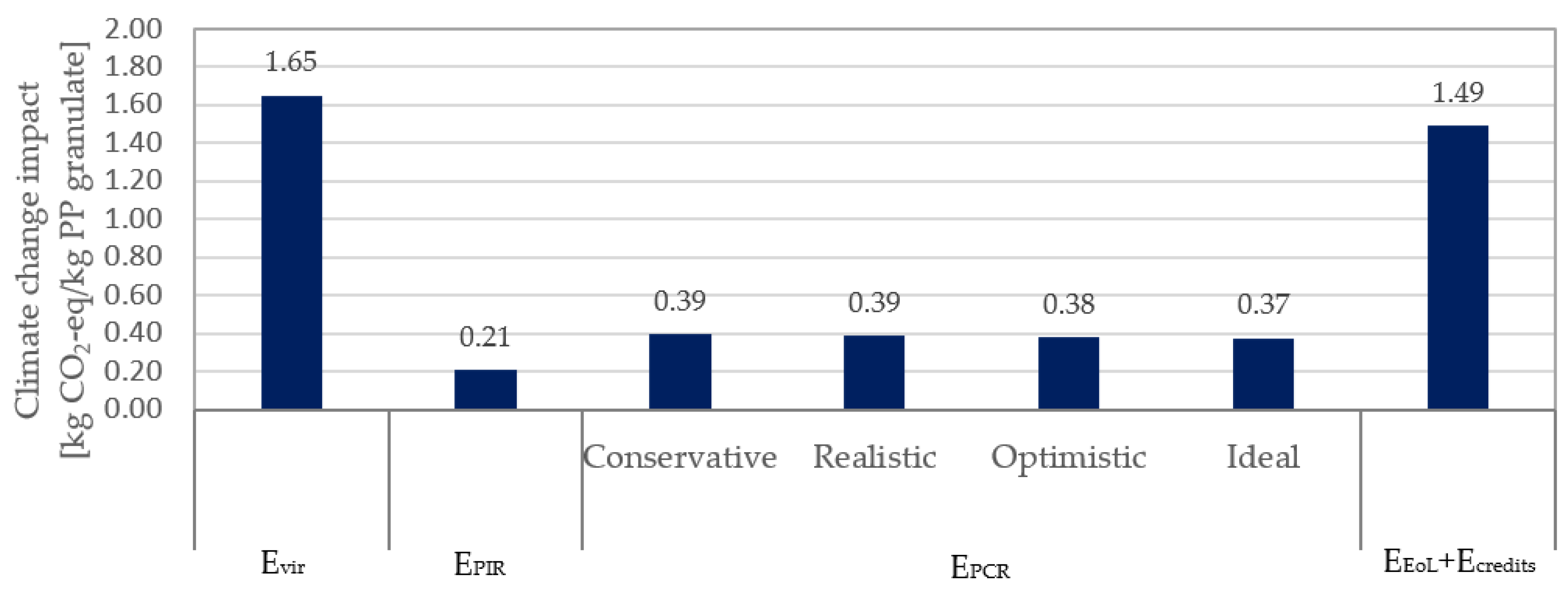
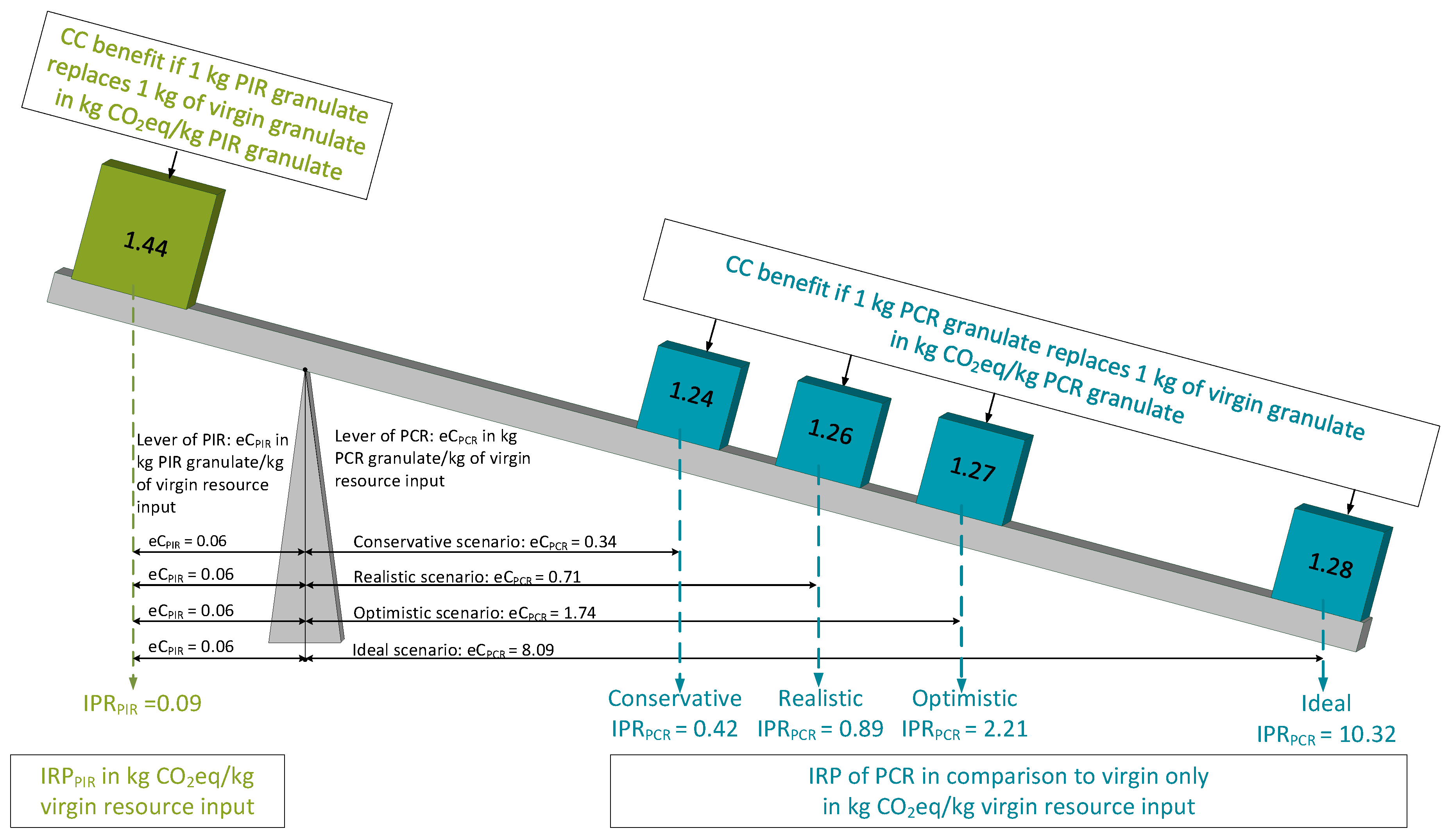
| Scenario | pPIW | CRPIW | RRPIW | pPCW,1 | CSRPCW | RRPCW | |
|---|---|---|---|---|---|---|---|
|
Linear scenarios |
Virgin only | 7.6 % b [61] | 0 % | 0 % | 92.4 b % [61] | 0 % | 0 % |
| Virgin + PIR | 7.6 % b [61] | 89.1 % b [61] | 96 %a | 99 %b | 0 % | 0 % | |
|
Circular scenarios |
Conservative | 38.9 %b [61] | 65 %c | ||||
| Realistic | 55.5 %b [49] | 75 %c | |||||
| Optimistic | 75 %c | 85 %c | |||||
| Ideal | 99 %c | 90 %c | |||||
| a: primary data based on PP | |||||||
| b: literature values based on plastics | |||||||
| c: estimation based on different literature values | |||||||
Disclaimer/Publisher’s Note: The statements, opinions and data contained in all publications are solely those of the individual author(s) and contributor(s) and not of MDPI and/or the editor(s). MDPI and/or the editor(s) disclaim responsibility for any injury to people or property resulting from any ideas, methods, instructions or products referred to in the content. |
© 2023 by the authors. Licensee MDPI, Basel, Switzerland. This article is an open access article distributed under the terms and conditions of the Creative Commons Attribution (CC BY) license (http://creativecommons.org/licenses/by/4.0/).





